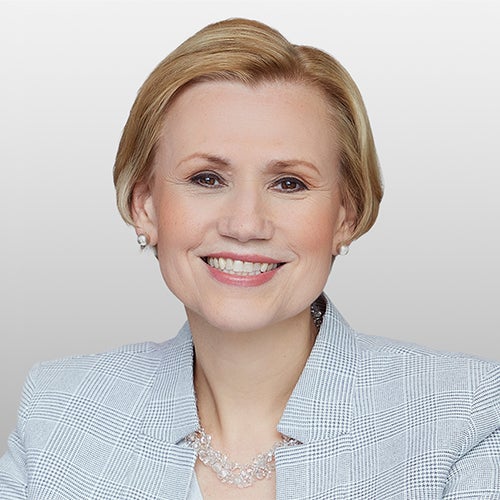Mid-Year Outlook: Anticipating economic acceleration and temporary inflation

Key takeaways
Our base case
Tail risk 1
Tail risk 2
In just over a year, the world has gone through incredible change – thrown into a pandemic and plunged into a global recession. Since the start of the pandemic, we have sought to make sense of this “black swan” scenario, sharing our insights and outlook with our clients.
We last put out an outlook at the end of last year, sharing our expectations for 2021. In that outlook, our base case anticipated an effective vaccine rollout that improved confidence and lowered infection rates, with the US experiencing a strong economic re-opening in the second quarter, followed by the eurozone. We favored risk assets and preferred cyclicals over defensives in this environment. We have largely seen that expectation come to fruition.
Now as we look to the back half of 2021, we at Invesco again brought together some of our most experienced investment professionals and thought leaders to provide a mid-year update to our outlook. To continue to address the breadth of possibilities that may lie ahead in the environment, we are providing a base case scenario, which we believe is highly probable, and two other possible scenarios that explore two different tail risks.
Our base case: A strong economic re-acceleration with temporary inflation
Our base case anticipates that economies will likely accelerate as they re-open, but expects any accompanying rise in inflation to be temporary. In our opinion, the United States has had a very effective vaccine rollout and is likely to take the lead in the global economic recovery as growth in China moderates. The UK and eurozone are likely to follow the US recovery, with some emerging markets countries generally lagging behind because of the obstacles they face vaccinating their respective populations, which is likely to result in episodic resurgences of COVID-19. As economies re-open and spending increases, inflation should rise significantly, especially in the US as the Federal Reserve expects, but we anticipate it will moderate to a rate faster than pre-crisis trends but not sufficient to induce aggressive action from central banks. Over the longer term, we expect demographics and innovation to place downward pressure on inflation.
In our base case scenario, we expect investors to be rewarded for taking on more risk, and so we favor equities, real estate, and industrial metals. Given our expectation of a strong economic recovery, within equities we favor value over growth, and industrials, materials, and financials over defensives. We also favor smaller-cap stocks in this environment. In fixed income, we expect high yield and investment grade credit to outperform government bonds. In terms of regions, we favor Europe and emerging markets, which we believe should be helped by expectations of improving economic growth as well as a weaker dollar.
Tail risk 1: Pandemic resurgence
Our first tail risk scenario contemplates a resurgence of the pandemic as a result of the spread of more powerful virus mutations against which existing vaccines are substantially less effective. In our view, this would have a negative impact on economic growth globally, but we believe the impact would not be nearly as dramatic as the initial wave of COVID-19 because economies have learned to adapt to lockdowns and have developed other tools to control the spread of the pandemic. Emerging markets economies would likely be hit hardest due to relatively limited health care infrastructure as well as lower vaccination levels.
In such a lower-growth environment we would favor gold, sovereign debt, investment grade credit and cash. Within equities, we would favor defensive sectors with stable cash flows and wider margins. Conversely, cyclical sectors should underperform as the recent value rotation comes to a halt, with financials hit by a flattening of the yield curve.
Tail risk 2: High inflation
Our second tail risk scenario describes a strong economic re-acceleration accompanied by a rise in inflation that is more persistent. In this scenario, we believe rapid growth would come with a quickening pace of inflation. Markets would anticipate higher inflation and Fed tightening, causing the yield curve to steepen on the back of rising inflation expectations but no Fed rate hikes in sight over our scenario period, which is one year.
In this scenario we would favor commodities, equities, real estate, and inflation-protected bonds. Within equities, we would expect to find increased dispersion in sector performance, exacerbated by differences in interest rate sensitivity, with financials likely benefitting from a steeper yield curve. Long-duration sectors such as consumer staples, health care and technology should underperform, while sectors with real asset characteristics such as industrials, materials and energy should outperform. In fixed income, we would look for risky credit, except for EM debt, to outperform government bonds.
Looking ahead
Given the unique nature of this economic crisis, many factors will dictate the path of the economic recovery in the second half of 2021 and beyond. We will be closely following vaccination levels and COVID-19 infection rates along with fiscal policy, monetary policy, and economic conditions as we progress through the back half of 2021.
Sources
-
1 Source: Bloomberg, L.P. Past performance is not a guarantee of future results. An investment cannot be made into an index.
2 Source: CNBC, “Fed’s Jim Bullard sees first interest rate hike coming as soon as 2022,” June 18, 2021
Investment risks
-
The value of investments and any income will fluctuate (this may partly be the result of exchange rate fluctuations) and investors may not get back the full amount invested.
Important information
-
Data as of 28 June 2021 unless stated otherwise.
This document is marketing material and is not intended as a recommendation to invest in any particular asset class, security or strategy. Regulatory requirements that require impartiality of investment/investment strategy recommendations are therefore not applicable nor are any prohibitions to trade before publication. The information provided is for illustrative purposes only, it should not be relied upon as recommendations to buy or sell securities.
Where individuals or the business have expressed opinions, they are based on current market conditions, they may differ from those of other investment professionals, they are subject to change without notice and are not to be construed as investment advice.
The yield curve plots interest rates, at a set point in time, of bonds having equal credit quality but differing maturity dates to project future interest rate changes and economic activity.
Stocks of small and mid-sized companies tend to be more vulnerable to adverse developments, may be more volatile, and may be illiquid or restricted as to resale.
The risks of investing in securities of foreign issuers, including emerging market issuers, can include fluctuations in foreign currencies, political and economic instability, and foreign taxation issues.
The profitability of businesses in the financial services sector depends on the availability and cost of money and may fluctuate significantly in response to changes in government regulation, interest rates and general economic conditions. These businesses often operate with substantial financial leverage.
Businesses in the energy sector may be adversely affected by foreign, federal, or state regulations governing energy production, distribution, and sale as well as supply-and-demand for energy resources. Short-term volatility in energy prices may cause share price fluctuations.
The health care industry is subject to risks relating to government regulation, obsolescence caused by scientific advances and technological innovations.
Many products and services offered in technology-related industries are subject to rapid obsolescence, which may lower the value of the issuers.
Fixed-income investments are subject to credit risk of the issuer and the effects of changing interest rates. Interest rate risk refers to the risk that bond prices generally fall as interest rates rise and vice versa. An issuer may be unable to meet interest and/or principal payments, thereby causing its instruments to decrease in value and lowering the issuer’s credit rating.
A value style of investing is subject to the risk that the valuations never improve or that the returns will trail other styles of investing or the overall stock markets.
Growth stocks tend to be more sensitive to changes in their earnings and can be more volatile.
Commodities may subject an investor to greater volatility than traditional securities such as stocks and bonds and can fluctuate significantly based on weather, political, tax, and other regulatory and market developments.
Fluctuations in the price of gold and precious metals may affect the profitability of companies in the gold and precious metals sector. Changes in the political or economic conditions of countries where companies in the gold and precious metals sector are located may have a direct effect on the price of gold and precious metals.
Issuers of sovereign debt or the governmental authorities that control repayment may be unable or unwilling to repay principal or interest when due, and the Fund may have limited recourse in the event of default. Without debt holder approval, some governmental debtors may be able to reschedule or restructure their debt payments or declare moratoria on payments.
In general, stock values fluctuate, sometimes widely, in response to activities specific to the company as well as general market, economic and political conditions.
Investments in real estate related instruments may be affected by economic, legal, or environmental factors that affect property values, rents or occupancies of real estate. Real estate companies, including REITs or similar structures, tend to be small and mid-cap companies and their shares may be more volatile and less liquid.


